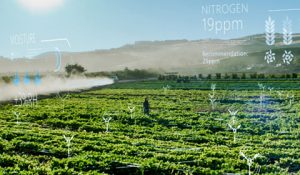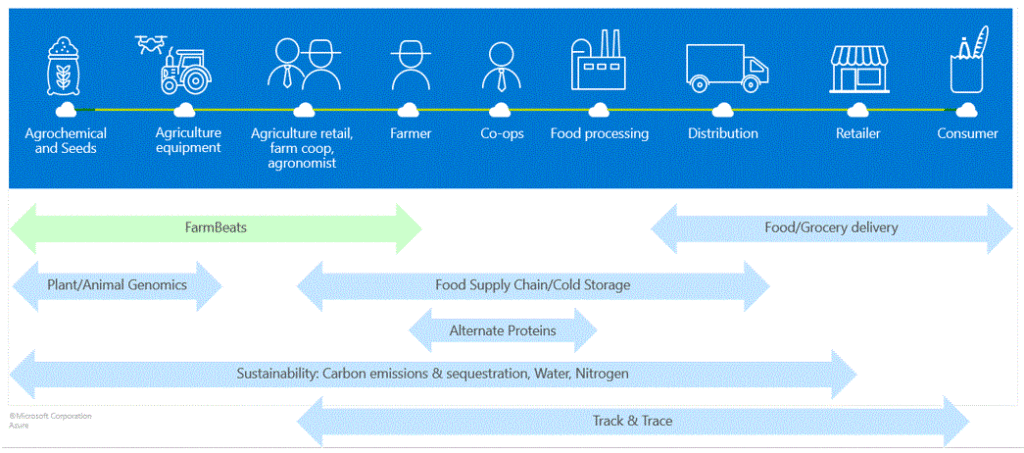Towards sustainable and nutritious agriculture and food systems
 Global food production needs to increase by 50% by 2050 compared to today’s levels to feed the growing population of the world. And, we need to meet this demand despite the limited amount of arable land and receding water levels, and while reducing the impact to the environment. This problem is even more severe if we consider the challenge of nourishing the world, instead of just feeding the world.
Global food production needs to increase by 50% by 2050 compared to today’s levels to feed the growing population of the world. And, we need to meet this demand despite the limited amount of arable land and receding water levels, and while reducing the impact to the environment. This problem is even more severe if we consider the challenge of nourishing the world, instead of just feeding the world.
Farming worldwide, including in the developed world, relies heavily on the instinct and guesswork of farmers, instead of the ground truth and farm data. For example, the amount of fertilizer applied in the farm is often based on previous year’s yield instead of the nutrient requirements of the soil. Farmers typically spray water and pesticide uniformly throughout the farm, instead of where they are needed.
One of the most promising approaches to address this challenge is data-driven agriculture. Using the latest advances in AI and cloud computing a farmer can learn about when to sow the seed, what pests are likely to occur in their fields, and use precision agriculture techniques to apply farm inputs such as water, nutrients, and pesticides. These advances will help the farmer increase yields, reduce costs, grow revenue, and employ sustainable agriculture practices. This will also drive the employment of people managing the farm network, and digital advisory services.
Additionally, the world also has a nutrition problem. Per the Global Nutrition Report, more than a third of reproductive age women are anemic, and 39% adults are overweight or obese. It is estimated that malnutrition could cost society up to $3.5 trillion per year. Even in the developed world, diets high in sugary drinks, fast food, and refined grains are main contributors to heart disease, diabetes, and obesity.
However, there is no solution that fits every individual. Studies have shown that the glucose and triglyceride levels vary differently for individuals, even after eating the same meal. The current trend of Keto or celebrity diet or food pyramid only works for a fraction of the population. This variation is a result of the individual’s microbiome, and other factors.
A potential solution to this malaise is personalized nutrition. It refers to personalization of the dietary intake, typically to prevent or treat chronic diseases, based on age, race, gender, DNA, health history, and lifestyle. The best diet for one individual might be very different than the best diet for another.
We believe in a future of food in which:
- Every person in the world gets right amount of calories
- The food contains the adequate nutrients
- Consumers treat food as preventive medicine
- … all of this without compromising taste!
Opportunities from feeding to nourishing

To achieve food and nutrition security, we need to:
- Grow more food in the same amount of arable land
- Ensure food is not wasted in the supply chain
- Learn nutritional deficiencies and provide recommendations
- Ensure nutritious and personalized food is delivered to every person
One way to achieve the above is by making the food supply chain data driven. If we can capture data from every component of the food supply chain, and securely share with other parts of the supply chain, and analyze it using the latest AI algorithms, it will help drive efficiencies in each component, for example, to grow more food sustainably in the farm, enable track and trace, reduce food waste, improve productivity in food processing plants, and synthesize new food.
Azure FarmBeats (opens in new tab) allows on-farm data to be collected and analyzed using AI for digital advisories to growers. While this gives us a head start compared to competition, we need to do a lot more, as shown in figure 1, to get to the vision of personalized, healthy food production and consumption.
Driving the future of food at Microsoft
Microsoft will take a combined research + engineering approach to help this important industry meet challenges in this industry. We will build differentiated tech that can help bring data to drive efficiencies across these areas of the entire food chain.
- Supply chain: Once a produce is harvested, we lose all information about how it was grown, e.g. when it was planted, whether it was watered, what chemicals were applied, etc. However, the nutrient content of the produce depends in large part on the way it was grown.
- Sustainability: There is a need to make farming sustainable -70% of global water resources are needed for Agriculture, 24% of global greenhouse emission comes from Agriculture. 251T liters of water to be saved in 2030 from implementing Smart Agriculture.
- Personalizing food for the consumer: The food needs to be personalized for nutrition and taste. Gut microbiome tests can reveal the best food for a customer, which can then be used to personalize food for the customer. Furthermore, the food needs to taste good as well.
- Emerging markets: Faster genome sequencing and analysis, with the advent of CRISPR tech, has led to the development of new seeds and soil biologicals, and development of ingredients that can help fix the flavor, fragrance, or sweetness. This process involving computational chemistry and molecular discovery is very time consuming. Food companies spend billions of dollars in R&D for the development of new ingredients.

